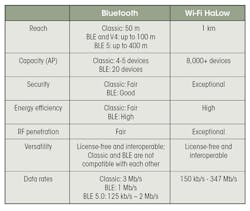This article is part of the TechXchange: IoT & Narrowband Communications.
Today, the Internet of Things (IoT) is relevant to almost every industry and is one of the fastest-growing sectors of IT. Last year, spending on IoT reached a whopping $300.3 billion and it’s expected to reach USD $650.5 billion by 2026.
With the world of IoT becoming an essential part of our lives, businesses must understand how to support the growing connectivity needs that come with this new era.
Not All Connections are the Same
The first thing to note is that not all connectivity is the identical. Wi-Fi HaLow, which incorporates IEEE 802.11ah and is one of the latest Wi-Fi protocols in the IEEE 802.11 family, was engineered specifically to meet the unique needs of IoT environments.1
Wi-Fi HaLow facilitates a more comprehensive approach to IoT wireless connectivity. It can deliver all of the benefits that consumers have come to expect from Wi-Fi today, while providing a tenfold increase in connectivity range as well as significantly lower power consumption for thousands of devices connected to the same access point. Like other modern Wi-Fi technologies, Wi-Fi HaLow also allows for multi-vendor interoperability, easy setup without disrupting existing Wi-Fi networks, and the latest Wi-Fi security.
What About Bluetooth?
Bluetooth is a popular wireless personal-area-network (WPAN) protocol used in many consumer devices such as smartphones, wireless headphones, and portable speakers for short-range communication. It is unlikely to support IoT use cases that rely on large numbers of low-power devices connected over long distances.
This comparison considers two separate Bluetooth versions: Bluetooth Classic and Bluetooth Low Energy (BLE), also known as Bluetooth 4.0. The table below presents a comparison of Wi-Fi HaLow with Bluetooth, showing how the two protocols stack up.
Going the Distance
Wi-Fi HaLow operates in the sub-1-GHz band with narrower channels (from 1 to 16 MHz), while Wi-Fi 4, 5, and 6 use channels with bandwidths from 20 to 160 MHz. The lower RF frequencies of Wi-Fi HaLow, which range from 850 to 950 MHz (compared to 2.4 or 5 GHz for Wi-Fi 4 or Wi-Fi 6), and range-optimized modulation and coding schemes, enable Wi-Fi HaLow devices to exceed a range of 1 km.2
By comparison, the Bluetooth standard operates in the 2.4-GHz ISM band and may support a maximum range of about 100 meters outdoors with no obstructions. However, most Bluetooth-enabled consumer devices operate indoors and at shorter ranges, generally 9 to 12 meters.
The latest Bluetooth version 5.0 offers a long-range mode known as Coded PHY. It enables Bluetooth connectivity to range beyond even 1 km outdoors with no obstructions but at a low fixed 125-kb/s data rate.
The practical range of any wireless protocol also depends on physical barriers or obstacles between devices. As a sub-1-GHz protocol, Wi-Fi HaLow offers exceptional penetration through obstacles of materials such as glass, wood, metal mesh, or concrete. By comparison, Bluetooth signals in the 2.4-GHz band experience more attenuation and are more easily blocked by obstacles than Wi-Fi HaLow signals.
Capacity Counts
A single Wi-Fi HaLow access point (AP) can handle thousands of connected devices. This capacity is a key feature when it comes to handling the huge number of IoT devices for larger-scale deployments in commercial buildings, factories, and other industrial applications. In a home setting, a single Wi-Fi HaLow AP can easily scale to meet the IoT demands of a typical household.
While the stated capacity for standard Bluetooth connectivity is up to seven devices, the practical capacity tends to be in the range of three or four devices. BLE offers greater capacity, but not by much. The practical limit for a central BLE device is about 20 devices. For this reason, BLE requires a mesh network to handle a larger number of devices.
Bluetooth Mesh was developed to meet that need, enabling the development of large-scale networks where hundreds or even thousands of Bluetooth devices can communicate with one another. However, because the payload of a Bluetooth mesh packet is small at 11 bytes, segmentation must be used to send larger packets, and packet size and number of mesh hops adversely affect packet latency.3
Keeping Connectivity Secure
As an IEEE 802.11 Wi-Fi protocol, Wi-Fi HaLow follows globally recognized standards for secure IoT authentication and communication. HaLow supports the latest Wi-Fi requirements for authentication (WPA3) and AES encryption of over-the-air (OTA) traffic, with data rates that enable secure OTA firmware upgrades.
Although Bluetooth was originally “not intended to be a secure protocol” in and of itself, it has recently improved its security. For example, BLE now supports AES-CCM cryptography and 128-bit encryption. In addition, the Bluetooth Special Interest Group (SIG) continues to monitor and improve Bluetooth security features.
Energy Efficiency of Bluetooth and Wi-Fi HaLow
Wi-Fi HaLow was engineered to address the low-power requirements for a range of IoT applications, including sensor, audio, and video applications. It offers one of the most energy-efficient connectivity options, using only a fraction of the power of other versions of Wi-Fi.
Bluetooth Classic is primarily used for audio applications. It can transfer larger files, such as still images or low-rate videos, and is still relatively energy-efficient when compared to Wi-Fi 4, 5, or 6. BLE is more energy-efficient than Bluetooth Classic and designed for sensor applications and LE audio, consuming 10X less power than Wi-Fi 4, 5, or 6.
Versatility of Connectivity
Wi-Fi HaLow employs the unlicensed and class-licensed sub-1-GHz band, ranging from 850 to 950 MHz. Providing vendors achieve Wi-Fi Alliance certification for their Wi-Fi HaLow products, they will interoperate with other Wi-Fi HaLow-enabled products and networks.
It’s worth noting that Wi-Fi HaLow and other Wi-Fi versions (Wi-Fi 4, 5, and 6) are all part of the IEEE 802.11 standard and operate on different RF bands, enabling them to coexist without impact to RF performance. This is a key advantage for networks designed to capitalize on Wi-Fi HaLow’s unique benefits of long range, superior penetration, and energy efficiency.
Bluetooth similarly uses the unlicensed 2.4-GHz band; the Bluetooth SIG also offers certain qualifications. However, Bluetooth Classic and BLE aren’t compatible, which means devices such as cell phones typically implement both versions to communicate with different end Bluetooth devices in the same band.
Comparing Data Rates
Wi-Fi HaLow provides a range of data rates ideally suited for IoT devices, for example from 150 kb/s using MCS 10 with BPSK modulation, to a top rate of 4.4 Mb/s using MCS 9, with a single spatial stream at the narrowest bandwidth of 1 MHz. In an 8-MHz operating channel, a single-stream Wi-Fi HaLow AP can support a mix of IoT devices from very-low-power sensors, sending 1-MHz packets at rates down to 150 kb/s, to cameras sending 8-MHz packets at rates up to 43 Mb/s.
Bluetooth has much lower data throughput—just a fraction of Wi-Fi HaLow’s top speed. Bluetooth Classic supports speeds up to 3 Mb/s, while BLE provides around 1 Mb/s (maximum 2 Mb/s if you’re using Bluetooth 5).
Final Thoughts
While many consider Bluetooth Classic to be an indispensable protocol for today’s wireless audio landscape, it doesn’t provide a comprehensive solution for diverse long-reach, high-capacity, low-power IoT networks.
If your networking needs call for secure, power-efficient, and large-scale connectivity, Wi-Fi HaLow provides the optimal overall solution for the diverse requirements of your IoT networks.
Read more articles in the TechXchange: IoT & Narrowband Communications.
References
1. https://www.wi-fi.org/discover-wi-fi/wi-fi-certified-halow

